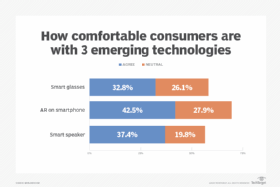
James Thew - Fotolia
Consider adopting extended reality for improved CX
Research shows that consumers are ready for extended reality when it comes to interacting with brands. Jason Cottrell explains why now is the time to consider adopting XR and AR.
Brands everywhere have been eagerly jumping on the smart speaker train. Retailers, especially, have recognized that the rapid inroads smart speakers have made into people's homes and routines has brought a significant opportunity with it. But while there are good reasons for brands to take advantage of this new channel and interface, there's something that may yet prove even more worthwhile -- something brands have largely overlooked to date. I'm talking about extended reality (XR).
XR is a blanket term for a few related types of experience including augmented reality (AR), virtual reality (VR), and mixed reality (MR). While similar, these experiences do differ and their distinctions matter, because it's part of what has slowed the adoption of this powerful, consumer-ready tech. When people think of XR, they often conjure images of expensive headsets and that seasick feeling that came with early VR experiences.
That image, however, is misplaced. Elements of XR can be extremely lightweight and accessible without being expensive, cumbersome equipment. Mobile XR has been largely overlooked by brands until now, but in studies conducted by my team we've discovered that consumers want certain XR experiences even more than they want smart speakers.
In short: Mobile XR and web XR are emerging as powerful spaces for connecting directly with consumers.
Consumers appear ready for extended reality experiences
In a recent Robots Among Us study -- a twice annual survey conducted to measure consumer comfort across a vast array of new and emerging technologies -- showed more comfort with augmented reality on our smartphones than with the smart speakers now permeating our homes. Even the much-maligned smart glasses performed quite well. (Who knew?)
Brands have a big opportunity with extended reality to reach customers. They've moved quickly to create engaging experiences with smart speakers, but by and large they've missed out on a market readiness for augmented reality on smartphones that could lead to big sales. As Myplanet designer Shanil Patel recently wrote, brands can implement XR with relatively low risk and investment, allowing them to take advantage of the so-called "magic window" to connect with customers in powerful ways.
According to the research, about 42% of consumers would feel comfortable with an AR smartphone app currently. That's promising in its own right for a relatively nascent technology, but an additional 28% fall into what we call a "neutral" category. Neutral respondents are often an indication of a lack of exposure to the technology or a lack of understanding about its use cases -- and accordingly, they're an indication of room to grow for that market.

Let's take a look at the smart speaker results for comparison. Smart speakers had a 37% comfort level, with just under 20% of respondents feeling neutral about them. That neutral score says a lot: Smart speakers have had an enormous amount of exposure and consumers are quite familiar with their operations and use cases, meaning they're less malleable in their opinions about them. Now, just over 55% of respondents being open to a technology is still an extremely positive indicator, and it points to why that market has been able to grow so quickly. But AR smartphone experiences outpace that by almost 15%. If 70% of consumers are open to the technology, it's probably one worth exploring.
As noted earlier, even smart glasses are showing promising signs of consumer readiness, outranking smart speakers with over 30% responding positively to their usage and an additional 26% being open to the idea of them.
These results show that brands -- retailers in particular -- have an incredible opportunity to connect to consumers directly in a new and novel way. Moreover, they can be among the first to do so, carving out a niche as a category leader.
Adopt extended reality before your competitors do
Consumers want to be here; they want to engage with this technology. This is a technology with low friction on the uptake and an extremely high value. Conversion rates have been shown to increase by up to 40% with the use of AR and 71% of consumers have said they would shop more often if they used AR. I don't need to tell you those numbers mean big things.
AR is effective because instead of telling, which has a limited capacity to capture the attention of your audience, you're showing. With AR, you can put the physical product in your customer's space and give them a real sense of what their space could look like with your product. Especially now, with COVID-19, when people are particularly wary of going into brick-and-mortar environments (and restrictions around how they can do so loom large), giving your customers a way to interact with your product is a powerful selling tool.
Additional research also shows that workplaces are bringing this technology on board with over half of the manufacturers reporting bringing in some form of AR in the last 12 months. More and more employers are turning to various modes of XR for training programs and creating more immersive meetings -- especially as limitations on in-person interactions take their toll. (Maybe you've already been part of an augmented meeting room.) As people grow more accustomed to using AR in their work lives, they'll come to expect it more in their private lives.
Think of the immediate ubiquity of the augmented Zoom background. Colleagues appearing in meetings from beaches, the insides of clock towers, outer space … it was easy to adopt and fun to mess around with, so people flocked to it. That's a secret that Snapchat and Instagram discovered some time ago. The social platforms have been taking advantage of AR filters to not only keep people engaged as users, but to further that connection as co-creators of the experiences. That kind of attention capture is not easy. Smart speakers are incredible for convenience, but they don't attract ongoing engagement in the way AR can. AR smartphone apps, with their extremely low barrier to entry and ability to immerse users in the experience, keeps consumers interested in your brand and what you have to offer.
Don't abandon smart speakers, just consider extended reality alongside
No one is suggesting that smart speakers were a mistake -- far from it, they're one of the most revolutionary experiences to come along in the last decade and we're confident their impact has only just begun. Voice can also serve as an excellent control mechanism for XR. But what if there's another experience, one that's been overlooked, that could produce an impact that might outstrip even voice devices? What if your brand took advantage of a market that wants to engage with that experience, and was able to improve customer satisfaction and increase engagement, sales, and loyalty in one low-friction experience? Wouldn't that be worth investing in right now? The extended reality landscape (and AR in particular) has been evolving at the margins of the tech bubble, waiting for the perfect moment to burst onto the scene. That moment is now.
About the author
Jason Cottrell is the founder and CEO of Myplanet, a software studio that specializes in creating digital experience platforms. For over a decade, Cottrell has worked closely with the world's leading companies including Google, Salesforce and IBM to create compelling, technology-driven solutions that address real user needs with a comprehensive, long-term vision for handling business challenges. Cottrell received his HBA from the Richard Ivey School of Business at the University of Western Ontario.






